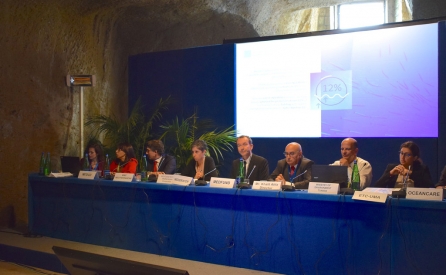Search
12/19: How to turn marine paper parks into real MPAs and safeguard the Mediterranean?
NGOs and Mediterranean organizations representatives presented their recommendations to enhance biodiversity conservation through MPAs during a side event held in Naples on the sidelines of the Barcelona Convention COP21.
“The Mediterranean is collapsing, (…) we need marine protected areas to secure our life tomorrow”, said Ms. Marie-Aude Sévin (IUCN-Med). Ms. Sévin recalled that when effectively managed, MPAs contribute to the recovery of declining species, habitats and biological communities. As a Nature-Based Solution (NBS), MPAs could be used also to protect ecosystems like seagrass meadows and saltmarshes which represent relevant carbon stocks, and consequently help mitigate climate change impacts. She recommended to co-fund NBS-focused projects with carbon market funds.
MPAs are a solution, but they need to be safeguarded from the growing Mediterranean blue economy. Many activities like shipping, recreational boating, fish farming are interfering with MPAs. The problem is that “MPA managers don’t engage in processes like Marine Spatial Planning and Integrated Coastal Zone Management, blue economy, etc.”, said Giuseppe Di Carlo (WWF). He recommended to foster their capacity to engage in the planning processes, and to integrate recommendations on sustainable interactions between blue economy and MPAs in their management plans.
Spain has “12% of MPAs not paper areas. (…) We have achieved the protection of over 12% of our marine surface, fulfilling with Spain's international commitments (Aichi Target 11)”, said Itziar Martín Partida (Ministry of Ecological Transition of Spain). This achievement is built on the results of long-term projects, the last one being the LIFE IP INTEMARES project (2017-2024). She explained that there are 5 prerequisites to success, that are the scientific research for the selection of MPAs and the design of the best management measures, conservation actions, monitoring and surveillance, governance & capacity building, and communication & educational actions.
On the other hand, when funding is lacking, not much can be done. “Only 10% of the necessary budget for marine conservation is made available. Hopefully, The MedFund has been launched and is operational”, said Mr. Khalil Attia, SPA/RAC director. The MedFund aims to create a global alliance of public and private donors to fund the daily operating costs of Mediterranean MPAs. “Effective management to move towards effective MPAs needs financial mechanisms”, said Romain Renoux, The MedFund Coordinator, adding that “The MedFund is more than just funding, it is also an aid coordination platform, a tool for policy dialogue, and a capacity building mechanism”.
Tunisia is one of the beneficiary countries of The MedFund, especially the Kuriat Islands, where local stakeholders join forces to manage the future MPA even before its formal legal declaration. Mr. Mohamed Ali Ben Temessek (Ministry of Environment of Tunisia) presented the process of creation of MPAs in his country, which is time-consuming, and said that Tunisia’s ambition is to protect 3% of its marine surface by 2020.
Civil society in Tunisia has enabled an “MPA without papers” (and not a “paper park”) to operate. In Spain, the civil society has pushed towards the establishment of one of the largest MPAs in the Mediterranean Sea. The 46,385 square kilometers-newly declared SPAMI is a migratory corridor used by many rare cetaceans, threatened inter alia by noise pollution generated by shipping and hydrocarbon exploration. “The impacts range from displacement to physiological, behavioral impacts, temporary hearing loss, permanent hearing loss up to death”, said Mr. Nicolas Entrup (Ocean Care). “There was an intense campaign, institutional and social, from NGOs and scientists (..) finally the Spanish government decided to protect this area”, said Mr. Carlos Bravo (Ocean Care). Currently, the challenge is to develop a management plan, within the forthcoming three years, that will help mitigate, reduce and avoid ocean noise within the MPA.
Are MPAs sufficient to ensure biodiversity conservation in the whole Mediterranean Sea? Most of the protected areas are located inside the national jurisdiction zones, while the impacts go beyond. “The managed areas are not necessarily in the most sensitive areas”, said Ms. Dania Abdul Malak (ETC-UMA). Ms. Abdul Malak presented the EBSAs as effective tools and policy processes to address transboundary pressures. “EBSAs works both within and outside MPAs”, she said.
The tools for biodiversity conservation are multiple and complementary. There is still a lot to do, the challenges are huge, and time is pressing. One key issue is environmental awareness. Ms. Ghada Ahmadein (RAED) presented several activities carried out in Egypt to raise awareness at several levels, and especially among children, so that the “youth will be able to make the change” as said Mr. Mostafa Fouda (Egyptian delegation at the COP21).




Find Us On...